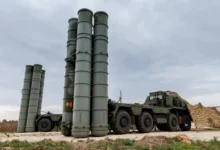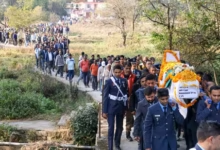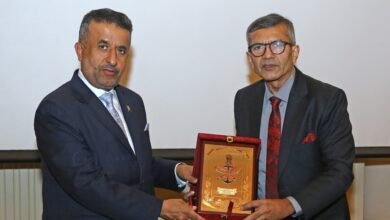Indigenous Combat Jets And Kaveri Turbofan Engine: All About IAF’s New Aerospace Plan

- India was never given important technical know-how like the "single crystal blade" technology for making airplane engines.
- The scheme to build an indigenous fifth-generation fighter would need more coordinated efforts and professional management.
Aerospace is the field of the future, and everyone agrees that whoever rules it will also control the world. The Indian Air Force (IAF) has a total of 31 units as of 2023. By 2025, three MiG-21 Bison groups will have been taken out of service.
With the addition of three Sukhoi-30MKI squadrons and two LCA-Tejas Mark-1 squadrons this year, the IAF will be able to keep up to 33 combat jet units despite losing some jets.
Another squadron of Jaguar deep penetration strike aircraft will also be taken out of service by 2027. This will bring the total number of units down to 32. So, if more fighter jets aren’t bought right away, there will be a shortage of 10 combat squadrons by 2030.
While the MMRCA 2.0 deal to buy 114 foreign fighter jets moves forward, steps are also being made to buy 114 indigenous fighter jets to fill in the gaps. Air power that depends on a lot of technology needs to replace assets more quickly because they become outdated more quickly.
Even though the IAF has a Plan B for fighting with what it has if it has to, the numbers are not enough to fully carry out an air operation in a two-front war. The IAF needs to quickly rebuild its squadrons and get modern jets that are as good as or better than those of its enemies.
India needs to make its own planes if it wants to become a world power. China has already made a lot of progress. The main two domestic combat aircraft projects are the Light Combat Aircraft-Tejas and the Advanced Medium Combat Aircraft (AMCA), and it is important to keep an eye on their progress.
CONCEPT OF 4th & 5th GEN JETS
The LCA-Tejas was first thought of as a fourth-generation fighter jet, while the AMCA is supposed to be a fifth-generation fighter. Most fighters of the fourth generation can do more than one thing. These jets use the “energy-manoeuvrability” concept to make “fast transients”—quick changes in speed, altitude, and direction—instead of just going fast. They are light aircraft with a higher thrust-to-weight ratio and use digital Fly-By-Wire (FBW) flight controls, which allow relaxed static stability flight and, in turn, agility.
The engines in these planes are controlled by computers. Pulse-Doppler fire-control radars allow you to look down and shoot down. Head-up displays (HUD), hands-on-throttle-and-stick controls (HOTAS), and multi-function displays (MFD) help pilots see what’s going on around them and move faster. Composite materials help cut down on the weight of an airplane. Better designs and processes for maintenance cut down on the time it takes for an aircraft to get ready for its next mission and allow it to fly more sorties. In this group are the F-16, F-18, MiG-29, SU-30 MKI, and Mirage-2000.
In the last 20 years, a sub-generation of fighters called the 4.5th generation has grown. These fighters have advanced digital avionics, newer aerospace materials, a small decrease in their signature, and highly integrated systems and weapons. The way these fighters work is based on networks. Some of the most important new technologies are multi-function active electronically scanned array (AESA) radars, BVR AAMs with a longer range, GPS-guided weapons, solid-state phased-array radars, helmet-mounted display sights (HMDS), and better secure data lines that are harder to jam.
The option to go supersonic without using the afterburner was added. Stealth features were mostly about lowering the radar cross section (RCS) from the front by using limited shaping methods. In this group were the Eurofighter Typhoon, the Dassault Rafale, and the Saab JAS 39 Gripen. New technologies were also added to many airplanes from the 4th generation. Both the Su-30MKI and the Su-35 had engine ports that helped them turn better.
The Lockheed Martin/Boeing F-22 Raptor, which came out at the end of 2005, was the first plane of the fifth generation. These planes were made from the start to work in a network-centered combat environment and to have extremely low, all-aspect, multi-spectral signatures by using advanced materials and shaping methods. AESA radars have a high capacity and a low chance of being intercepted. IRST and other sensors are fused in so that the pilot always knows what’s going on and can keep an eye on all items of interest in a 360-degree bubble around the plane.
Other features include advanced electronics and a glass cockpit, as well as better secure data links that are harder to jam. Very high-speed integrated circuit (VHSIC) technology and high-speed data buses are used a lot in avionics kits. “First-look, first-shot, first-kill capability” is the goal of fifth-generation fighters. They are very resistant to ECM and can also act as a “mini-AWACS.” Important features include combined electronic warfare systems, integrated communications, navigation, and identification (CNI), centralised “vehicle health monitoring”, fiber-optic data transmission, and stealth. Thrust-vectoring makes it easier to turn, and it also shortens the lengths needed to take off and land.
Built-in super-cruise. The main guns are kept in internal weapon bays to keep the radar cross signature (RSC) low. The Lockheed Martin F-35 Lightning II, Russia’s Sukhoi PAK FA (SU-57), China’s Chengdu J-20 and Shenyang J-31, and India’s AMCA are all projects to make fifth-generation fighters. Japan is also looking into whether or not it is technically possible to make fifth-generation fighters.
LCA TEJAS MARK-2
IAF has promised to get 200 Tejas Mark-2 planes, bringing the total number of Tejas planes it needs to more than 300 over the next 15 years. Tejas Mark-2 was supposed to keep the basic shape of an airplane and use the bigger and more powerful GE F-414 engine with a 98 Kilonewton thrust, which was more likely to meet the Tejas standards that had been agreed upon.
This would have required a big change to the air intakes, and the size and weight of the plane would have had to go up. ADA showed off a new version of the Tejas Mark-2 at Aero India-2019. They called it a Medium Weight Fighter (MWF). The IAF wanted the Medium Multi-Role Combat Aircraft (MMRCA), and this plane was meant to meet that need. The Tejas Mark-2 MWF, which is an improved form of the Tejas, would be 14.6 meters long and 8.5 meters wide, compared to 13 meters for the Tejas and 14.36 meters and 9.13 meters for the Mirage 2000.
The plane will have a delta-shaped wing with canards that are close together. It was said that this would lower drag from all points of view. Because the fuselage is longer, there will be more room for fuel behind the pilot. The Tejas Mark-2 would have a lot more fuel inside and outside of it. The plane would weigh up to about 17.5 tons, which is more than Mark-1’s 13.5 tons. Its ability to carry things in its external stores will also go up from 5.3 to 6.5 tonnes. It will have a General Electric GE-F414-INS6 turbofan engine with a Full Authority Digital Electronics Control (FADEC) system that will give it more power.
The Tejas Mark-2 will also have a 14.5 kg integrated life support system-onboard oxygen generation system (ILSS-OBOGS) and a combined electro-optic electronic warfare suite, among other improvements to the avionics. It will have a missile approach warning system (MAWS), an infrared search and track (IRST) system, and a modern AESA radar.
The MWF will be able to carry more guns because it can now carry up to 6.5 tonnes and has 11 weapon stations instead of seven. It is said to be made for a swing job, with BVR, close combat, and precision strike capabilities.
India’s fifth-generation fighter, the AMCA, can’t move forward until the Tejas Mark-2 design is set in stone. The most likely date for the first flight would be around 2028. The plane might join the IAF around 2034 or 2035. In any case, the 123 Mark-1 and Mark-1A jets will not be delivered by HAL for at least 7–8 years.
TWIN-ENGINE DECK-BASED FIGHTER (TEDBF)
The Indian Navy has sent out an RFI (Request for Information) about the possibility of buying 57 navy multirole fighter jets. But the Navy rejected the Tejas at first because it was too heavy. In August 2018, they started testing again with the NP-2 (Naval Prototype-2) and the first mid-air refueling happened in September 2018.
Operating the naval prototype will help with the building of a twin-engine deck-based fighter (TEDBF) aircraft. The TEDBF will be driven by two General Electric F-414 turbofans, and it will be able to carry more weight and travel farther.
OMNI-ROLE COMBAT AIRCRAFT (ORCA)Strong>
According to credible sources, India is also working on its future Medium Class Omni-Role Combat Aircraft (ORCA), which will have two engines. Canards, a supersonic outlet without a diverter, conformal wing root tanks or containers, more hard points, and the option for folding wingtips are all things that are planned for this platform.
It will be about 23 tons heavy. It is hoped that the first flight will happen in 2026 and that production will begin in 2030.
ADVANCED MEDIUM COMBAT AIRCRAFT (AMCA)
The AMCA is a fifth-generation fighter plane that is being made by HAL. It was designed by ADA. It will have two engines and be able to fight in all kinds of weather. It will have super-cruise, stealth, improved AESA radar, super-maneuverability, and advanced avionics. The jet will replace the Jaguar and Mirage 2000 planes and go with the Sukhoi-30 MKI, Dassault Rafale, LCA Tejas, and MiG 29K in the IAF and the Indian Navy.
On April 4, 2018, Nirmala Sitharaman, who was then the Defense Minister, told parliament that the program’s feasibility study was already done and that the IAF had already given the program the green light to start the AMCA technology demonstration phase before starting the full-scale engineering development phase.
In October 2008, the IAF had asked the ADA to make a thorough project report for a medium combat aircraft for the next generation. The IAF gave the ASQR for the AMCA in April 2010, which put the plane in the 25-tonne class. The first test flight of the plane’s prototype was supposed to take place in 2017.
DRDO planned to use two GTX Kaveri engines to power the plane. In October 2010, the government gave out Rs 100 crore to pay for feasibility research. In November 2010, the ADA asked for Rs 9,000 crore to pay for the building of two technology demonstrators and seven prototypes. ADA presented a 1:8 scale model at Aero India-2013. The AMCA design will have diamond-shaped trapezoidal wings attached to the shoulders and a canard-vertical V-tail with a big tail-wing attached to the fuselage. It will have a fly-by-optics control system with four digital channels that will use fiber optic lines.
The radar cross-section (RCS) would be lowered by changing the shape of the chassis and engine inlet and using radar-absorbing materials (RAM). AMCA will have a weapons bay inside, but there are also plans for a non-stealthy version with pylons on the outside.
Radar Cross Section (RCS) testing and low-speed and supersonic wind tunnel testing were said to be done by 2014, and the project definition part was done by February 2014. After HAL Tejas got IOC in January 2014, the Engineering Technology & Manufacturing Development (ETMD) phase began. It was said that the AMCA would take its first flight in 2018.
At Aero India-2015, ADA confirmed that work was going full steam ahead on big technological issues like thrust vectoring, super-cruising engines, AESA radar, and stealth technology. Russia was to help create Three-Dimensional Thrust Vectoring (TDTVC), AESA Radar, and stealth technology. Key technologies were also offered by Saab, Boeing, and Lockheed Martin.
At first, AMCA will use two GE-414 engines to fly. It will eventually be driven by two GTRE, 90-kilonewton thrust, K-9 or K-10 engines. These engines will replace the troublesome Kaveri engine. France has given full access to the Snecma M-88 engine and other key technologies, and the US has given full access to the GE F-414 and F-135 engines and offered to work with France on developing the engine.
AMCA PROGRAMME CLEARANCE
In 2019, different kinds of tests and analyses were to be done on two technology showcases and four prototypes. The truth is that they are a long way from it. By 2022, the Defense Ministry was asking the Cabinet Committee on Security (CCS) for permission to move forward with the prototype development phase. AMCA is meant to be a test case for basic research in India in the unfamiliar area of high-tech aviation. Aeronautical Development Agency (ADA) of DRDO had said that the first flight of AMCA would happen in 2020 and production would start in 2025, but now the first flight has been moved to 2026.
AMCA NAVAL VERSION
The Indian Navy became “involved” in the AMCA project for the first time in March 2013, when it asked the DRDO/ADA in an official letter if they were planning a naval version of the proposed jet. They looked at it in connection to the soon-to-be-built IAC-2 aircraft carrier. The navy has already asked for 57 MMRCA-2.0 class planes. They think that Naval AMCA (NAMCA) time shares will be the same as IAC-2. On September 7, 2015, the Navy gave DRDO its list of needs. They have said that NAMCA development should be done by a different team.
FOREIGN COLLABORATIONS
India told the foreign vendors of the MMRCA-2.0 program that the country’s need for fighters would require pledges to the AMCA. This is because India is not sure of its own ability to make fighters. Most vendors have set up joint ventures with big Indian defense companies and built research and production facilities to get ready. The IAF fully supports the project, but it hopes that the dates given are accurate, because if they aren’t, it will mess up the way it buys things.
In any case, the 114 jets made by the Indian Air Force (IAF) will help make up for some delays. In the meantime, DRDO has been talking with Indian defense companies like Tata, Mahindra Defence, Larsen & Toubro, and a number of smaller, more specialized companies about work-sharing for AMCA. Some of India’s private industry is already making big things for defense companies like Lockheed Martin, Boeing, Airbus, BAE Systems, and others.
The AMCA is a project that is being worked on at the same time as India’s Ghatak stealth robotic combat aircraft. Many labs are looking into technologies that can be used on both systems. These technologies include shape, stealth, network-centricity, sensors, and materials.
BOOSTING INDIGENOUS TURBOFAN TECH
The turbofan engine is thought to be the most important part of a jet plane, since it can’t fly without it. A turbofan-based power plant gives airborne combat vehicles the thrust they need to glide through the air and turn very quickly. In 1986, DRDO’s Gas Turbine Research Establishment (GTRE) began work on a project called “Kaveri” to make an Indian turbofan engine.
As part of the Light Combat Aircraft (LCA)-‘Tejas’ project, the turbofan engine was to be made from scratch. In April 1989, the power plant’s full-scale development was given the green light as part of a 93-month plan with a $55.3 million budget. The original plan was to build 17 test engines to see how they worked. The first test engine was just the core module, which was called “Kabini.” The third prototype was the first to have variable input guide vanes (IGV) on the first three compressor stages.
In March 1995, the Kabini core engine ran for the first time. The first full Kaveri prototype started being tested in 1996, and all five ground-test prototypes were being tested by 1998. The first flight tests were set to start at the end of 1999, and the first test flight on an LCA prototype was set for the following year.
But problems with both politics and technology slowed down the Kaveri development effort. After India did a series of nuclear bomb tests at Pokhran-2 in 1998, the US put economic and technological bans on India. This made it harder for India to get important aero-engine technologies and parts from the US.
In the years that followed, the Indian science establishment had to figure out everything on its own. When the first prototypes were tested on the ground, they were found to be throwing up blades. The engine failed its high-altitude tests in Russia in the middle of 2004, ending dreams that it would be used in the first batch of Tejas fighter jets. As the delay went on through the first half of the 2000s, the engine had been tested for 1700 hours and sent twice to Russia for high altitude tests by February 2008.
In July 2007, GTRE split the Kaveri program into two different programs: the K9+ program and the K-10 program. Before the launch of the production version of the K-10 standard engine, K9+ is used to prove the idea of full design and get hands-on experience with aircraft engine integration and flight trials. This is done to cover a defined, truncated flight envelope.
The K-10 program is a joint venture (JV) with an engine maker from another country. K-10 is meant to be the last normal production Kaveri engine. It will be lighter and have more thrust when reheated, among other changes, to meet the original design goals. By May 3, 2010, different versions had been put through about 1,880 hours of engine tests.
Eight Kaveri engines and four core engines were made, put together, and tested. Testing of the core engine at a high altitude had also been done safely. On November 4, 2010, one of the Kaveri prototypes, the K-9, flew safely for the first time at the Gromov Flight Research Institute in Moscow. The test was done at the Flying Test Bed in Gromov. The engine was running from takeoff to landing, and the plane went up to a height of 6 km and flew for more than an hour.
On its first flight, the engine helped the IL-76 testbed reach speeds of about 0.6 Mach. During the flight, it was found that the engines were easy to handle, worked well, and were in good health. With this test, Kaveri had reached a big development goal. But when the CAG report came out in 2011, it shocked many people because it showed that the program had gone over budget and that only two of the six goals had been met. CAG said that the engine was too big and that there hadn’t been much work on the compressors, turbines, and systems that control the engine.
The Kaveri project was finally about to end, as DRDO planned to stop the program in 2014 because it had been delayed for so long. But an offer from France’s Safran Aircraft Engines, which used to be called Snecma, gave everyone hope. As part of the Dassault Rafale offsets deal, France offered to spend 1 billion Euros and suggested a joint venture with DRDO to quickly restart the Kaveri engine program and get the first upgraded engines ready for flight.
The good news finally came on November 20, 2016, when CP Ramanarayanan, the head of DRDO’s Aeronautics Cluster, said that a deal had been made with the French company Safran Aircraft Engines to upgrade Kaveri and make it ready for tests by 2018.
As of 2022, the plan is to improve the first run of prototypes by transferring a lot of M-88 engine technology from France to India. This will make Kaveri airworthy and allow it to be built into the Tejas PV-1 (Prototype Vehicle-1) aircraft.
French experts who looked at the engine said that 25–30% more work needs to be done to make it safe for flying. It is known that there are many arms trade lobbyists in the government who don’t want the indigenous turbofan engine program to happen because it will make it harder to get F-404 and F-414 engines from the United States.
These people who are in charge of getting arms into the country are so strong that they can make people think that night is day and day is night. India was never given important technical know-how like the “single crystal blade” technology for making airplane engines. DRDO had to start from scratch with almost everything. Now it’s up to the NDA-3 government to make Kaveri work as soon as possible, with the first historic flight on an LCA-Tejas plane happening right away, probably during the next Defense Expo in 2024.
THE FUTURE
The Indian defense production sector’s most important programs are Tejas and AMCA. making warships and battle tanks is a lot easier and cheaper than making planes. India had a hard time getting FOC airplane production for the base Tejas model. This shows that India needs help from outside the country. The AMCA will still have to deal with the unknowns and worries. For the engine, AESA, and EW systems, there needs to be a joint venture or a transfer of knowledge.
Also, the AMCA will need help from outside to deal with its complicated aerodynamic setups and stealth. Given how slowly the Tejas project is moving forward, it will be a hard job. The scheme to build an indigenous fifth-generation fighter would need more coordinated efforts and professional management.
When there are problems with technology, people need to face the hard truth and raise their hands instead of playing “hit and trial.” Working with other countries to create cutting-edge technologies and systems will stop delays and cost increases that have never happened before. Now is the time to move. Don’t wait any longer.







Facebook Comments